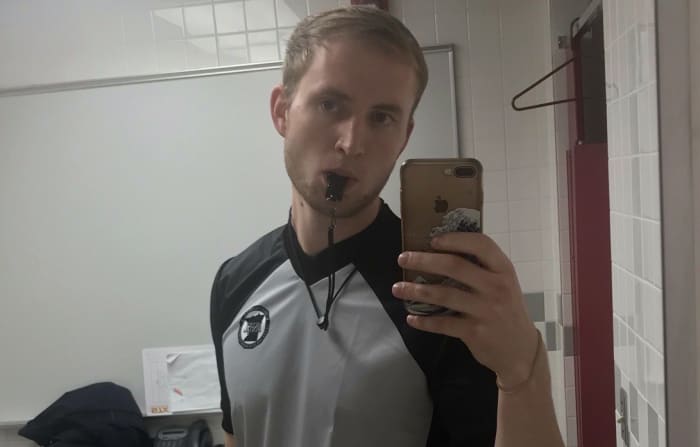Student-loan borrowers are preparing to resume their payments this month after a three-year-long pause due to the COVID-19 pandemic. And the impending payments aren’t just putting a crimp on clothes, sneakers and nights out — they’re prompting lifestyle resets, stretching work schedules and sapping budget wiggle room, borrowers say.
In Michigan, teacher Audra DeRidder, 27, is picking up extra duties at her school district while working an evening shift at a bar and restaurant.
In Texas, Alex Espinoza Acosta, 23, opted to move back home after college instead of paying rent. He’s churning out cover letters and attending job interviews in hopes of work that pays better than his current mix of contract work and bartending.

Alex Espinoza Acosta decided moving back home, instead of paying rent, was the best way to prepare for the loan payments ahead.
Alex Espinoza Acosta
And in Minnesota, Zachary Dykes, a 25-year-old chemist at a Minneapolis-area paint company, recently paid off $30,000 of his $55,000 in student debt through “rigorous cost cutting” and side work refereeing youth sports.
The pause began in March 2020, in the pandemic’s early, dark days. It’s ending in a moment with its own distinct challenges: hot inflation that’s receding slowly, rising credit-card debt, high interest rates and a cooling labor market with fewer job openings.
What’s more, the moratorium stretched so long that the lives and financial commitments of many borrowers have changed. More than a third of borrowers say they’ll need to cut up to $500 from their budget for the upcoming bills, according to a survey last month by the National Endowment for Financial Education, a nonprofit focused on financial wellbeing.
The Supreme Court in June blocked the Biden administration’s efforts to cancel up to $20,000 in student debt for millions of borrowers, and President Joe Biden later announced he would try to cancel student debt under a different legal authority.
“I didn’t take on the loans with the hope that somebody would forgive them or they would be wiped clean,” said Amir Nijem, a 32-year-old husband and father of three. Nijem has more than $70,000 in student-loan debt, with most coming from a master’s degree he recently earned from the University of Chicago.
In July, Nijem started taking weekend shifts at a car valet service. That’s on top of his full-time job with the city of Chicago.

Amir Nijem, 32, has more than $70,000 in student-loan debt.
Amir Nijem
Caught in a work-life bind
DeRidder, a fifth-grade teacher in Michigan’s Upper Peninsula, graduated from college $20,000 in debt in the spring of 2020, even after receiving a full-ride scholarship and working throughout school.
Ahead of her first student-loan bill, so much about her life has changed: She’s now married and the mother of a 2-year-old daughter — and the recipient of an approximately $640 daycare bill each month. She isn’t sure how much the royalties for her recently published children’s book, “I’m Just Too Much,” will help.
DeRidder and her husband have been paying his $500 monthly private student-loan payments throughout the pandemic. Now they’ll pay another $100 for her federal loans and another $150 for his.
DeRidder started picking up her weeknight shift at the bar and restaurant over the summer. A shift is typically about six hours, ending around 10 p.m. It was easier to handle when school wasn’t in session — but now there’s the school week; plus eight hours of extra work handling special-education paperwork; plus the restaurant shift, which has recently been paying around $60 a night.

Audra DeRidder, shown here with her book, “I’m Just Too Much,” has a busy schedule to accommodate student-loan bills.
Audra DeRidder
“I’m stressed out as a teacher, because if I’m out having to work extra or bartend, I’m tired the next day,” she said. “I’m not as good. I’m not as creative. I’m not as fun.”
There are others out there in more dire financial straits than hers, DeRidder quickly acknowledged. But that’s cold comfort, given the schedule in front of her.
The extra work to accommodate her and her husband’s combined $250 monthly payment is “doable,” DeRidder said, but not “sustainable.” “It’s just also not a great way to live life — just constantly working, and the mental exhaustion that comes with always worrying about your finances and making sure you have bills timed out right,” she said.
In Chicago, Nijem has already clocked some seven-day workweeks since picking up the valet work. The six- to eight-hour valet shifts, paying roughly $20 an hour, have served as a “buffer” that pays for food, gas and incidentals between paychecks. This month, Nijem plans for the money to go toward loan payments, which he expects will be about $300.
Fridays are typically pizza night for Nijem’s family. Now that loan payments are restarting, pizza nights and other such fun occasions will need “a second thought,” he said.
Like DeRidder, Nijem is caught in a work-life bind. Nijem remembers his parents being “just constantly at work.” The need for the valet wages are a “fact of life.” But he worries about the personal price of that extra income as he watches his children — ages 8, 6 and 1 — grow up.
“I do want to be present, and I don’t want these precious moments to slip by because of work,” he said hours ahead of a Friday-night shift.
Interest-rate attack
There was a late-August surge in student-loan payments, researchers recently noted. One theory is that it was a wave of student-loan borrowers paying off principal before interest began accruing in September.
Dykes, the Minneapolis-area chemist, was part of that crowd. But to make those payments, he said, he largely eliminated the money he spent on going out. He also picked up side work refereeing youth basketball, flag football and volleyball.
Dykes has already halved his balance — but it’s hard to see that as an accomplishment, he said. “It just stinks to have two jobs. It stinks having to give up weekends, and it stinks not to have the financial flexibility to do everything I want.”

Dykes’s extra work refereeing will help him with the student-loan bills ahead.
Zachary Dykes
He plans to pay the $255 a month required of him for the next several months and nothing more. That buys him time to replenish the rainy-day savings he drained with the early payment. For now, he added, “I’m flying close to the sun.”
Dykes will eventually increase payments above that amount, applying the excess cash to his loans with the highest interest rates.
Will his refereeing continue? “Until I’m debt free, I’d say definitely,” Dykes said.
‘Unreal’ rents and a cooling labor market
Espinoza Acosta, the recent college graduate in Texas, said it would have been nice to live on his own after graduating.
But then he thought about his $25,000 in student-loan debt, and his aims for graduate school or law school and eventually homeownership. He also considered the “unreal” rents in the Austin area, where the median rent in August was $1,670. So he moved back to the San Antonio suburbs to live with his brothers, sister, grandfather, mother and stepfather.
That decision has helped him and his family with day-to-day costs, which seem to keep increasing. He contributes $500 toward household groceries and utilities. He has also seen his car-insurance payments shoot from $200 to more than $400 in less than a year.
“Student loans definitely don’t make it easier,” Espinoza Acosta said. He applied for an income-driven repayment plan, but admitted he hasn’t worked up the nerve yet to check what his monthly bill will be.
Espinoza Acosta brings in $4,000 a month through contract work for a labor union, a remote job assisting University of Texas school administration and bartending. He tucks away 5% to 10% of each paycheck into a high-yield savings account and now has $2,000.
He also occasionally puts money into the stock market, hoping for returns that exceed the rates he’s getting now on his savings account. “If I had rent, I would definitely not be able to save,” he said.
Espinoza Acosta’s main strategy for tackling his loan payments is sending out more job applications for positions with better pay. He has been on around 30 interviews for nonprofit-sector work, usually once or twice a week, he said. Would-be employers tell him the positions require more work experience. But “no one’s going to gain entry if you don’t give them entry,” he said.
As the job market cools, spotting and landing a good job is easier said than done. Of course, Espinoza Acosta said, it might be easier to find even more work in the retail and food industry.
But his resume already includes years at a Starbucks
SBUX,
and a McDonald’s
MCD,
“I’ve done my time, I would say,” he said.
